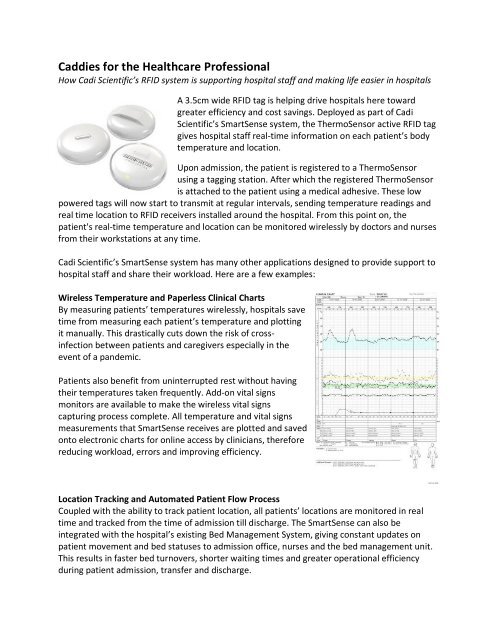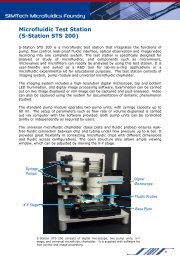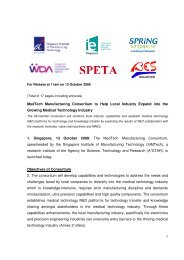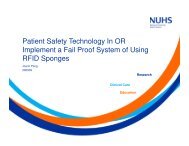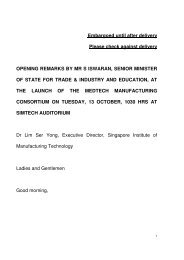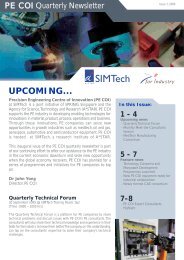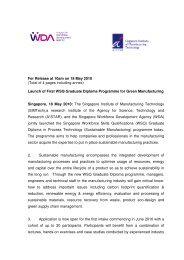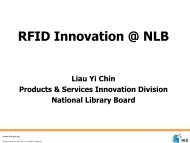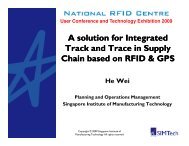Cadi Scientific.pdf - National RFID Centre
Cadi Scientific.pdf - National RFID Centre
Cadi Scientific.pdf - National RFID Centre
Create successful ePaper yourself
Turn your PDF publications into a flip-book with our unique Google optimized e-Paper software.
Caddies for the Healthcare Professional <br />
How <strong>Cadi</strong> <strong>Scientific</strong>’s <strong>RFID</strong> system is supporting hospital staff and making life easier in hospitals <br />
A 3.5cm wide <strong>RFID</strong> tag is helping drive hospitals here toward <br />
greater efficiency and cost savings. Deployed as part of <strong>Cadi</strong> <br />
<strong>Scientific</strong>’s SmartSense system, the ThermoSensor active <strong>RFID</strong> tag <br />
gives hospital staff real‐time information on each patient’s body <br />
temperature and location. <br />
Upon admission, the patient is registered to a ThermoSensor <br />
using a tagging station. After which the registered ThermoSensor <br />
is attached to the patient using a medical adhesive. These low <br />
powered tags will now start to transmit at regular intervals, sending temperature readings and <br />
real time location to <strong>RFID</strong> receivers installed around the hospital. From this point on, the <br />
patient's real‐time temperature and location can be monitored wirelessly by doctors and nurses <br />
from their workstations at any time. <br />
<br />
<strong>Cadi</strong> <strong>Scientific</strong>’s SmartSense system has many other applications designed to provide support to <br />
hospital staff and share their workload. Here are a few examples: <br />
<br />
Wireless Temperature and Paperless Clinical Charts <br />
By measuring patients’ temperatures wirelessly, hospitals save <br />
time from measuring each patient’s temperature and plotting <br />
it manually. This drastically cuts down the risk of crossinfection between patients and caregivers especially in the <br />
event of a pandemic. <br />
<br />
Patients also benefit from uninterrupted rest without having <br />
their temperatures taken frequently. Add‐on vital signs <br />
monitors are available to make the wireless vital signs <br />
capturing process complete. All temperature and vital signs <br />
measurements that SmartSense receives are plotted and saved <br />
onto electronic charts for online access by clinicians, therefore <br />
reducing workload, errors and improving efficiency. <br />
<br />
<br />
<br />
Location Tracking and Automated Patient Flow Process <br />
Coupled with the ability to track patient location, all patients’ locations are monitored in real <br />
time and tracked from the time of admission till discharge. The SmartSense can also be <br />
integrated with the hospital’s existing Bed Management System, giving constant updates on <br />
patient movement and bed statuses to admission office, nurses and the bed management unit. <br />
This results in faster bed turnovers, shorter waiting times and greater operational efficiency <br />
during patient admission, transfer and discharge.
<br />
Besides patient tracking, SmartSense can be used to locate hospital assets as well. This helps <br />
staff locate their equipment for immediate use as well as for preventive maintenance. <br />
<br />
After a few trials in several Singapore hospitals, Tan Tock Seng Hospital moved first to deploy <br />
the SmartSense system in 2007 to facilitate patient flow and also recently upgraded it to <br />
include Wireless Temperature Monitoring and Electronic Clinical Charts as well. Amongst other <br />
benefits, the <strong>RFID</strong> system has helped increase hospital efficiency, information transparency and <br />
reduce patient waiting times. <br />
<br />
Other hospitals are starting not only to realise but also accept the benefits of <strong>RFID</strong> and its <br />
potential in healthcare. Singapore General Hospital is already in their last phase of hospitalwide SmartSense deployment with their exisiting Premise Bed Management System to <br />
automate their patient flow process. Across the border, Sunway Medical <strong>Centre</strong> and Pantai <br />
Putri Ipoh are the first hospitals in Malaysia to implement an active <strong>RFID</strong> solution hospital‐wide <br />
for patient tracking. Their SmartSense Systems are expected to go live in the second quarter of <br />
this year. <br />
<br />
About <strong>Cadi</strong> <strong>Scientific</strong> <br />
Backed by a panel of experienced medical advisors and a renowned professor, <strong>Cadi</strong> <strong>Scientific</strong> <br />
was incorporated in Singapore to harness latest technology to develop wireless sensing and <br />
tracking devices for healthcare. <br />
This resulted in the SmartSense system‐ an <strong>RFID</strong> wireless platform designed to enhance patient <br />
care, reduce nurses’ workload and improve operational efficiency. Useful applications include <br />
wireless temperature and vital sign monitoring on digitized clinical charts, patient tracking for <br />
optimizing patient flow and real‐time asset tracking to optimize utilization of assets. <br />
<br />
<strong>Cadi</strong> <strong>Scientific</strong> Pte Ltd <br />
31 Ubi Road 1 <br />
#03‐00 Aztech Building <br />
Singapore 408694 <br />
Tel: 65‐6276 2676 <br />
Fax: 65‐6276 6216 <br />
Email: info@cadi.com.sg <br />
Web: www.cadi.com.sg <br />


